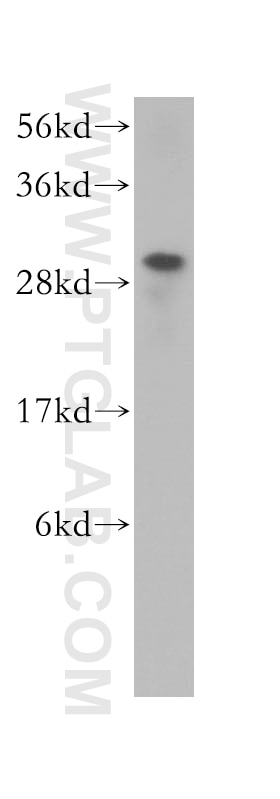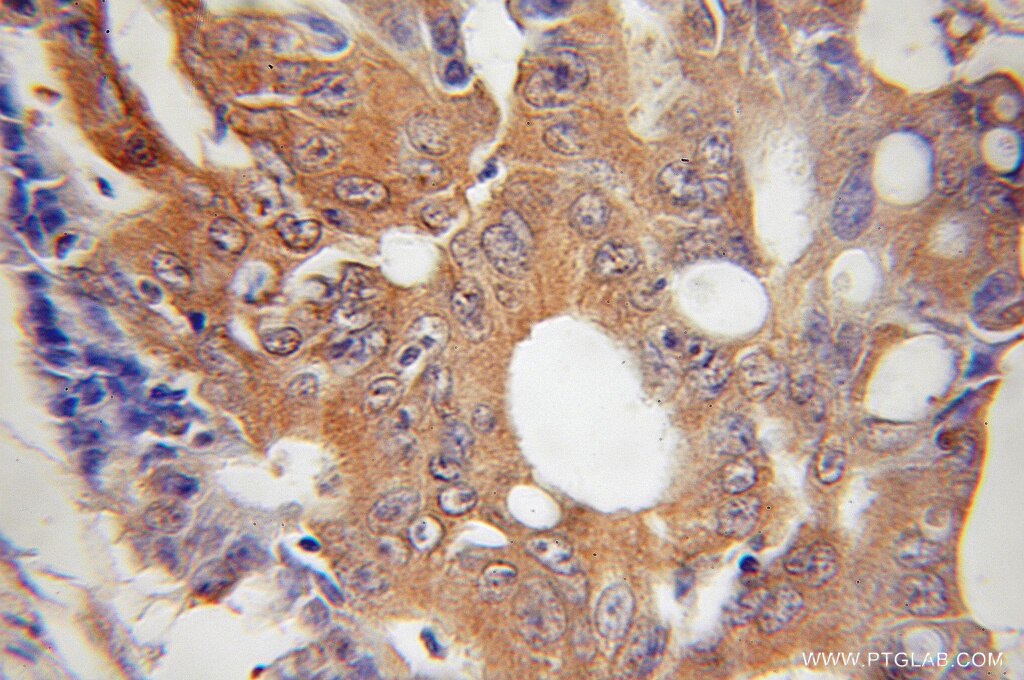- Phare
- Validé par KD/KO
Anticorps Polyclonal de lapin anti-HUS1
HUS1 Polyclonal Antibody for WB, IHC, ELISA
Hôte / Isotype
Lapin / IgG
Réactivité testée
Humain
Applications
WB, IHC, IF, ELISA
Conjugaison
Non conjugué
N° de cat : 11223-1-AP
Synonymes
Galerie de données de validation
Applications testées
| Résultats positifs en WB | cellules BxPC-3 |
| Résultats positifs en IHC | tissu de cancer du côlon humain il est suggéré de démasquer l'antigène avec un tampon de TE buffer pH 9.0; (*) À défaut, 'le démasquage de l'antigène peut être 'effectué avec un tampon citrate pH 6,0. |
Dilution recommandée
| Application | Dilution |
|---|---|
| Western Blot (WB) | WB : 1:300-1:1000 |
| Immunohistochimie (IHC) | IHC : 1:20-1:200 |
| It is recommended that this reagent should be titrated in each testing system to obtain optimal results. | |
| Sample-dependent, check data in validation data gallery | |
Applications publiées
| KD/KO | See 1 publications below |
| WB | See 5 publications below |
| IHC | See 1 publications below |
| IF | See 1 publications below |
Informations sur le produit
11223-1-AP cible HUS1 dans les applications de WB, IHC, IF, ELISA et montre une réactivité avec des échantillons Humain
| Réactivité | Humain |
| Réactivité citée | Humain |
| Hôte / Isotype | Lapin / IgG |
| Clonalité | Polyclonal |
| Type | Anticorps |
| Immunogène | HUS1 Protéine recombinante Ag1744 |
| Nom complet | HUS1 checkpoint homolog (S. pombe) |
| Masse moléculaire calculée | 32 kDa |
| Poids moléculaire observé | 32 kDa |
| Numéro d’acquisition GenBank | BC007013 |
| Symbole du gène | HUS1 |
| Identification du gène (NCBI) | 3364 |
| Conjugaison | Non conjugué |
| Forme | Liquide |
| Méthode de purification | Purification par affinité contre l'antigène |
| Tampon de stockage | PBS with 0.02% sodium azide and 50% glycerol |
| Conditions de stockage | Stocker à -20°C. Stable pendant un an après l'expédition. L'aliquotage n'est pas nécessaire pour le stockage à -20oC Les 20ul contiennent 0,1% de BSA. |
Informations générales
Hus1 belongs to the Rad family, form a heterotrimeric clamp with Rad1and Rad9 that acts as a putative sensor for DNA damage. This complex plays an apical role in the DNA damage response, loss of a functional complex affects many downstream checkpoint pathways [PMID: 11340080]. It is also a key complex involved in the activation of the ATR pathway. 9-1-1 forms a ring-shaped heterotrimer, resembling the homotrimeric sliding clamp, proliferating cell nuclear antigen (PCNA) [PMID: 19535328].
Protocole
| Product Specific Protocols | |
|---|---|
| WB protocol for HUS1 antibody 11223-1-AP | Download protocol |
| IHC protocol for HUS1 antibody 11223-1-AP | Download protocol |
| Standard Protocols | |
|---|---|
| Click here to view our Standard Protocols |
Publications
| Species | Application | Title |
|---|---|---|
Proc Natl Acad Sci U S A Uncoupling DNA damage from chromatin damage to detoxify doxorubicin. | ||
Oncogene DNA damage-induced translocation of mitochondrial factor HIGD1A into the nucleus regulates homologous recombination and radio/chemo-sensitivity. | ||
J Mol Cell Biol SUMO-1 modification of FEN1 facilitates its interaction with Rad9-Rad1-Hus1 to counteract DNA replication stress. | ||
Mol Carcinog HUS1 checkpoint clamp component (HUS1) is a potential tumor suppressor in primary hepatocellular carcinoma.
| ||
Am J Physiol Cell Physiol Succinylation at a key residue of FEN1 is involved in the DNA damage response to maintain genome stability. | ||
Dis Markers Discovery and Validation of Novel Methylation Markers in Helicobacter pylori-Associated Gastric Cancer. |



